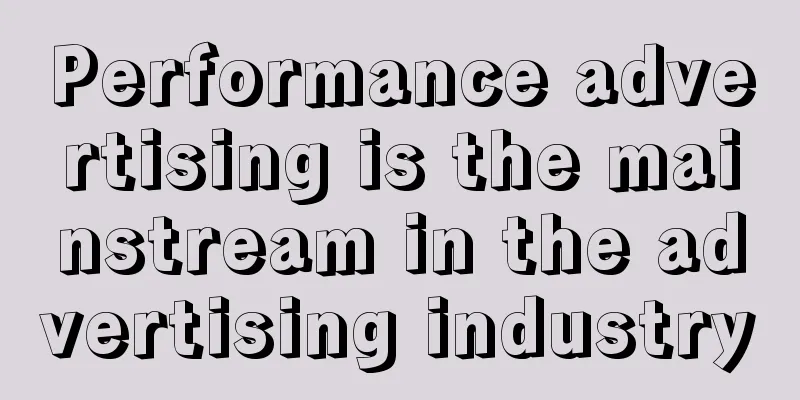|
Changes in the advertising industry After experiencing the crude buying of volume and extensive growth under the mobile traffic dividend and short video information flow dividend, the traditional buying method is no longer applicable, and the buying industry is undergoing a continuous reshuffle! Advertising professionals have more or less felt that the entire buying volume market has undergone major changes, that is, almost all advertisers are pursuing results, and private domain data is becoming more and more important . At the same time, the rapid changes in the industry have also caused anxiety in the entire advertising buying market , including anxiety among advertisers, advertising agencies, and advertising practitioners... Due to the economic fluctuations in recent years and the impact of the 2020 epidemic, advertisers' advertising budgets have been affected to varying degrees, so the requirements for advertising have become conservative, especially for brand owners, which have gradually moved towards performance-based advertising . However, the big spenders in the performance advertising industry, such as gaming, e-commerce and other industries, have always operated based on the model of making back every penny spent , so they are relatively more adaptable and less affected. In fact, the advertising spending of the top advertisers has increased instead of decreased . Of course, due to the soaring traffic costs in recent years, the requirements for conversion effects have become increasingly higher. Yes, performance advertising is the mainstream in the advertising industry . Anxiety in the advertising industry The change in attitude of the media giants is actually very obvious. In the past, advertising agencies competed on their ability to provide funds. Large agencies like Yunrui actually have strong financial advantages and can easily become the exclusive agent or core agent of high-quality media. However, in the past two or three years, the media has begun to discover and encourage agencies that can provide effective advertising. If they cannot provide results, even the most well-funded agencies will still face elimination. Therefore, for advertising agencies, the ability to provide effective advertising conversions is the foundation, and funding is just a bonus . This is indeed very different from a few years ago. Traditional advertising agencies and practitioners should be quite anxious. The same goes for advertisers. Their anxiety comes from the uncertainty about the future of the buying volume market. After all, the traffic dividend is gone, and several traffic giants have basically taken shape. However, in these mainstream media, advertisers and agents are passive, and the trends in advertising purchases, including policies, are determined by the media . Coupled with the rapid development of short videos and live broadcasts in recent years, the requirements for content in advertising are becoming increasingly higher, and the requirements for advertisers in terms of refined delivery will also become increasingly higher . At the same time, driven by performance advertising, the direct investment platforms of these giant media are also constantly upgrading to win more advertising budgets from advertisers. In order to allow advertisers to quickly increase their volume, direct investment platforms provide bidding methods such as oCPM and oCPC, as well as compensation subsidy policies during the learning period. To be honest, compensation during the learning period is probably a benefit that only giant media outlets dare to offer. Moreover, the functional support of direct investment platforms is becoming more and more complete . Take the recently widely publicized Tencent advertising "one-click to increase volume" and the newly launched "one-click inheritance" function of Bytedance as an example. The media's recent upgrading momentum is also quite strong, and they are also competing with each other, fearing that advertisers' budgets will go to others. As the Spring Festival approaches, it is important for the media to be able to fire the first shot. Whoever can grab more Spring Festival budget and distance themselves from their competitors can also provide a strong assist for the completion of this year's KPI tasks. Relying on the large number of advertisers and advertising consumption (ByteDance's advertising revenue in 2020 is estimated to be between 150 billion and 155 billion, of which Douyin is approximately 100 billion to 105 billion), the data and algorithms of the media direct investment platform have become increasingly powerful, and the advertising effect has been guaranteed to a certain extent. Originally, the competition among media giants, coupled with the growth pressure faced by the giants themselves, is a good thing for advertisers, because advertising has become more and more "fool-proof" , greatly lowering the threshold for advertisers to place ads. But in fact, these have also directly led to increasingly fierce competition in buying traffic and large fluctuations in traffic costs. Therefore , advertisers have a love-hate relationship with the giant media platforms, but they cannot do without them and cannot quit . Ad optimizers who have grown along with the wild development of information flow advertising in recent years should also be quite anxious. On the one hand, with the rapid growth of the buying volume market, market practitioners could not keep up with the growth rate and a large number of optimizers poured in. The abilities of these optimizers varied and the threshold for entry was extremely low . Some are optimizers who transitioned over from the search advertising era, some have switched careers from other positions, and a large portion are fresh graduates who basically go straight to the job after simple training. Going into the battlefield with real money is the best training. After all, direct investment platforms are relatively fool-proof. On the other hand, precisely because of the fool-proof nature of the media direct platform, advertising placement relies more on manpower to build accounts, build plans, look at data, and make reports. Of course, another very important factor is creativity . Basically, slightly better optimizers have their own video creation skills, such as writing scripts, capturing shots, and doing editing. However, creativity is currently non-standardized, and with advertising analysis tools such as APP GROWING, a good video can easily be plagiarized and its life cycle is not long. Therefore, as the direct investment platform technology becomes more and more sophisticated, the growth space for optimizers has begun to be limited. The growth of optimizers over the years is more about the accumulation of experience rather than the accumulation of advertising optimization capabilities or advertising optimization methodology . Once they change media or industry, their so-called experience may not be useful and they have to start from scratch. It is conceivable how anxious advertising optimizers are. They worry about where their careers will go and even consider whether they should change careers. The importance of private data Since everyone is currently using the same functions for their placements on media platforms, you have it and I have it too, and competition has become increasingly undifferentiated . This model probably won’t last long. Visionary advertisers have already begun preparing to establish competitive advantages and build their own moats. Data is essential for advertisers to establish competitive advantages. The data mentioned here does not refer to the DMP data in Bytedance or Tencent Advertising. We generally call those public domain data, which can be used by all advertisers on this platform. The data I am talking about here mainly refers to private domain data, which is the advertiser's own unique data . Only by making full use of private domain data can we truly realize one of the core values of DSP at that time: user redirection. User redirection, nowadays people in the industry mostly refer to it as promoting activity or pulling activity. The premise is that you have enough user data and your product or service has medium and high frequency attributes. There should be a certain purchase frequency, so that there will be more scenarios for launching promotional/activation ads. Industries with medium and high frequency attributes include games, e-commerce, fast-moving consumer goods, finance, etc., while industries with low frequency attributes include automobiles, real estate, etc., because generally after buying a car or a house, there will be no demand for the next few years or even decades. In the past few years, many companies built their own DMPs because everyone was building DMPs and they naturally couldn’t fall behind. But in fact, many companies that built DMPs didn’t really use the data. At most, they put internal data on the dashboard to make it look a little cool... Then many companies built their own DSPs, but found that if they did not have enough user data and advertising budgets, it would be difficult to use DSPs because they would be subject to various restrictions. First, the media ADX docking restrictions did not meet the standards, and they would be cleared out if they could not be docked or if they did not meet the consumption requirements after docking. Second, their own data and algorithms were not as good as those of media direct DSPs, and naturally the conversion effects of the delivery were not as good either. Therefore, advertising delivery still cannot be separated from direct DSPs. Therefore, it was popular for advertisers to build their own DSP and DMP (CDP is more commonly mentioned in recent years), but few of them have actually put it into practice. In addition to the reasons mentioned above, many of them do not have enough determination to do this, and they easily give up when they encounter setbacks. Now, everyone is probably going to start chasing MKT API and RTA like crazy again... I just want to know if you have figured out what these words mean, what are their principles, and what they can be used for? Or do you just feel that these terms seem to be very popular, and you feel anxious, afraid that if you don’t do it, you will fall behind others? In order to better optimize the advertising buying effect, establish a data closed loop, and rationally utilize the API, it is naturally indispensable. However, if you do not understand the relationship between direct DSP and MKT API, RTA, and RTB, it is meaningless to pursue it blindly, and you may not know where to start. Author: A Breath of Cold Air Source: Advertising Practitioners Study Room |








![2022 Chengdu Tea Tasting Resources Drinking Tea Sharing Navigation Guide Those who have been here are full of praise [Sincere Night View]](/upload/images/67cc0ee4876f4.webp)

